The CDC predicted 1,395 new cases in Texas of HPV-associated cervical cancer by 2019. HPV-related cervical cancer cases are determined by the examination of cancer cell types in different parts of the body and it is believed that over 90% are due to HPV.
Less access to Pap testing and no follow-up treatment is presumed to be among reasons the rate of cervical cancer is higher among Latinas, as opposed to the myth that Latina women are more sexually active than White women.
Underlying factors for not getting a Pap smear, however, are far more complex for Latina women and include a range of reasons from lack of access to affordable care and minimal or no employer-based health coverage to fear of immigration status and language barriers. All are barriers that lead to the prevention, screening, and treatment of cervical cancer.
The good news is that with early detection, the disease can be treated and with Direct Med Clinic, testing is accessible. HPV vaccines can prevent cervical cancer and regular Pap tests are interventions that can improve cervical cancer screening for women.
Cervical Cancer
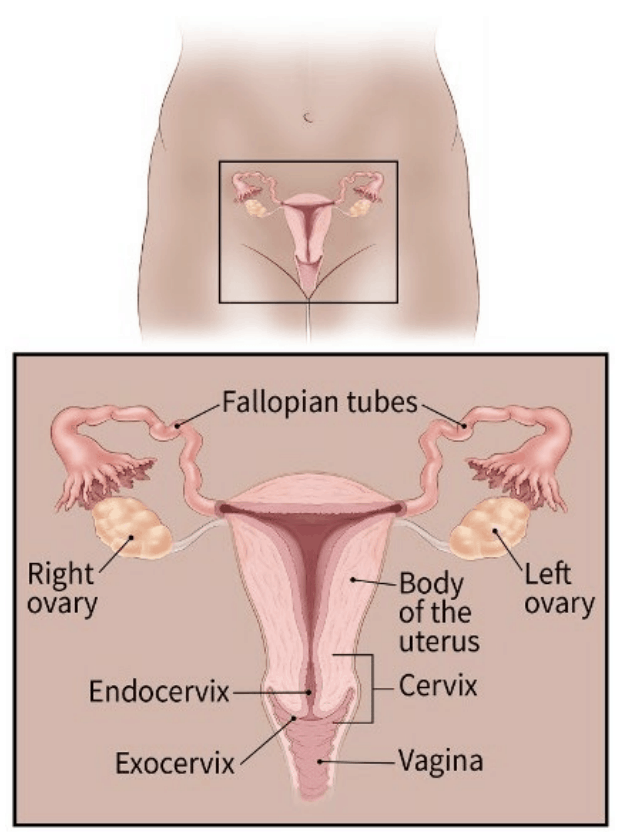
As explained by the American Cancer Society, cervical cancer is cancer that starts in the cervix, the part of the female reproductive system that connects the body of the uterus and vagina. Cancer slowly develops over time as normal cells become precancerous. Although most precancerous cells go away without treatment, some develop into cervical cancer. However, treating cervical pre-cancers can prevent almost all cervical cancers.
This is why screening is vital as it helps women find precancerous cells and are able to treat cervical cancer early or avoid cancer altogether. Human papillomavirus (HPV), usually a sexually transmitted infection, causes most cervical cancers. HPV is typically asymptomatic. Although most HPV infections go away on their own, some cells develop into cervical cancer. Risk factors for cervical cancer include smoking, weakened immune system, and overweight.
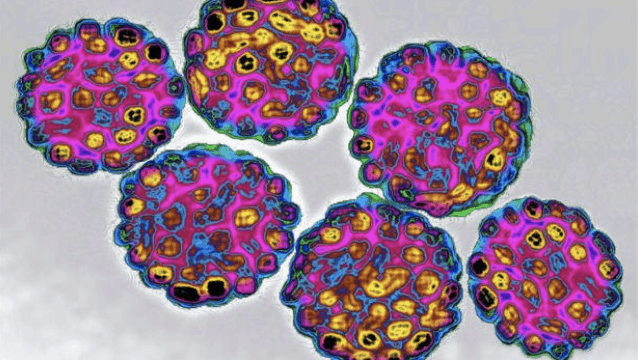
Never Had a Pap Test
For a cancer that is nearly 100% preventable, the statistics surrounding cervical cancer are staggering. 85% of women who die from cervical cancer never had a Pap test Latina women have the highest rate of HPV-associated cervical cancer than all other groups, although Black women experience the highest mortality rate.
According to the CDC, Latina women are 60% more likely to be diagnosed with cervical cancer and 30% more likely to die from it than their white peers. Recent studies and news reports in the last several years have found that the numbers are even higher than previously believed.
Lower Access to Healthcare
Health care access largely depends on insurance coverage, and lower insurance coverage means lower cervical cancer screenings. Latinos 18-64 years-old have the highest uninsured rates of any group in the United States at 25%, compared to 9% of non-Latino Whites.
Latinos also lack continuity of care, that is, do not see the same doctor (24% compared to 15%). Within the uninsured Latino populations, the highest are Mexicans/Mexican Americans (29%) and foreign-born (36%). At Direct Med Clinic, you can schedule a Pap Test without health insurance.

Cervical Cancer Screenings
Even more narrowly, 2019 surveillance report by the American Cancer Society found Texan women have far less cervical cancer screening, Pap tests, HPV tests and health insurance coverage than other Americans. 29% of Texan Latinos are uninsured compared to 12% of White Texans.
Demographics in San Antonio
As the Latino population in San Antonio increases, so will the rate of Latina women getting HPV-associated cancers each year without prevention. The Texas Demographic Center projections suggest “the Hispanic population will more than double its size in 2010 to over 20 million by 2050” in Texas. The Latino population in San Antonio is also growing at a steady, rapid rate. San Antonio second only to Phoenix, Arizona, has ranked among top cities for growth for the last several years as the city with the largest population increase according to the U.S. Census Bureau report.

Diagnosis and Incidence Rate
In 2018, 2,400 Hispanic women in the US were diagnosed with cervical cancer.
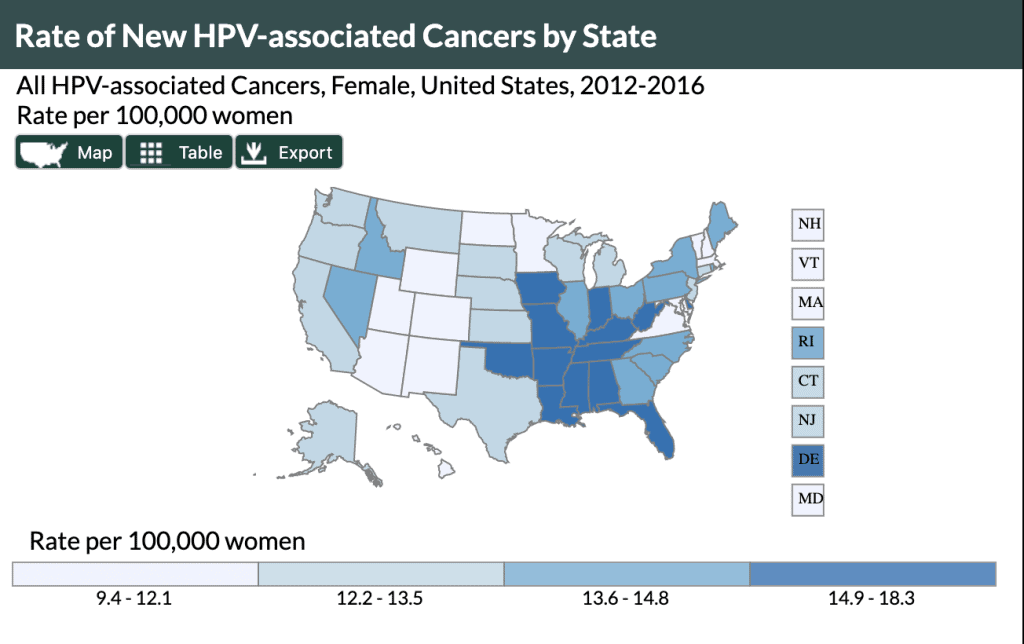
Of 100,000 women in the United States, the number of those diagnosed with HPV-associated cervical cancer would be:
- 8 black women
- 7 white women
- 6 American Indian/Alaska Native women
- 6 Asian/Pacific Islander women
- 9 Latinas were diagnosed with HPV-associated cervical cancer per 100,000 women
- 7 non-Hispanic women
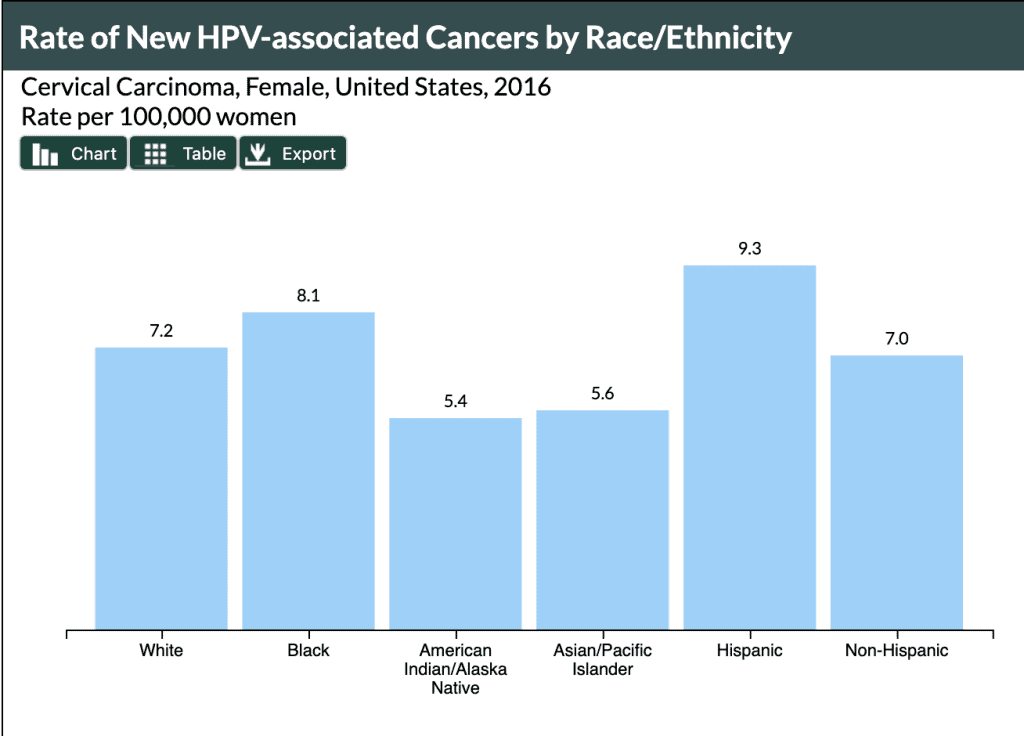
In all counties of Texas from 2012-2016, there were 6,168 new cases of cervical cancer. For every 100,000 women, 9 Cervical Cancer cases were reported. The rate of new cervical cancers per 100,000 was higher for Texans, at 9.3, but even higher for Bexar Latina Texans at 11.3.
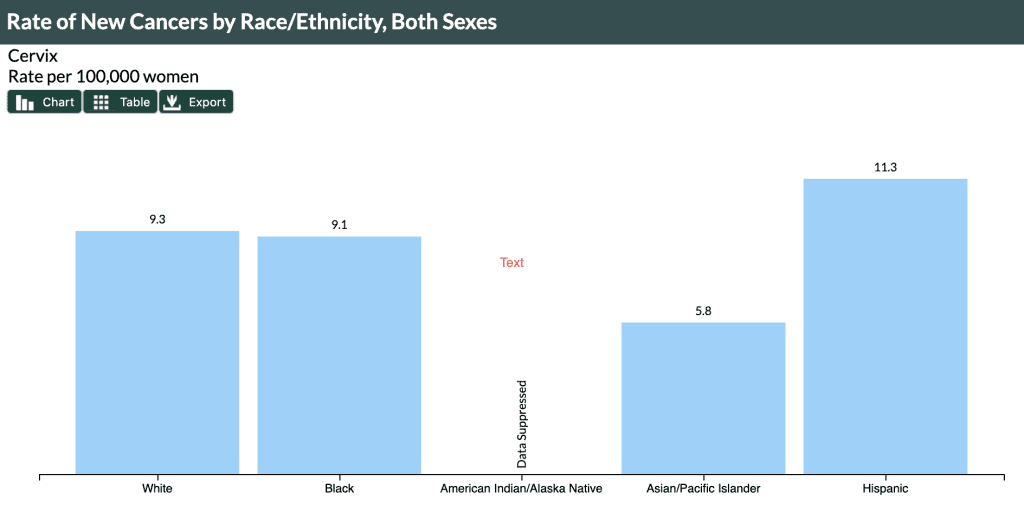
Is Cervical Cancer Deadly?
Cervical cancer untreated can lead to death. The leading cause of death among Latinas is cancer, not heart disease, as seen in other groups in the United States. Between 2012-2016, 1,962 women died specifically of cervical cancer in the United States. For every 100,000 women in Texas, 3 died of Cervical Cancer.
600 Latinas were expected to die in 2018 from cervical cancer. Despite the downward trends, death rates in Latinas were 26% higher than White women.
What is Cervical Cancer Screening?
A cervical cancer screening is a check for cancer or abnormal cells that may become cancer in people who have no symptoms. Tests involve sampling cells from the surface of the cervix and vagina. The Pap test examines cells under a microscope to search for abnormalities. The HPV test checks DNA or RNA for HPV infections in a lab. Unfortunately, Latina Texans are not getting cervical cancer screenings enough.
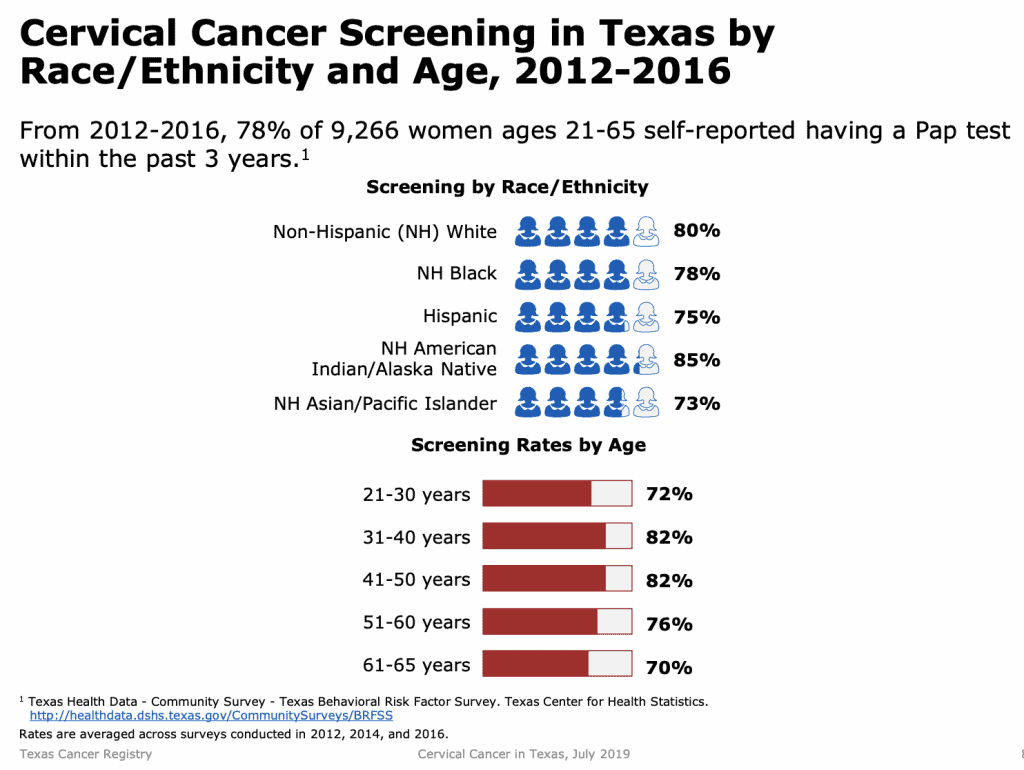
Numbers show that race and ethnicity, education and income to play a factor in cervical cancer screening for Latina Texans of Pap testing age.
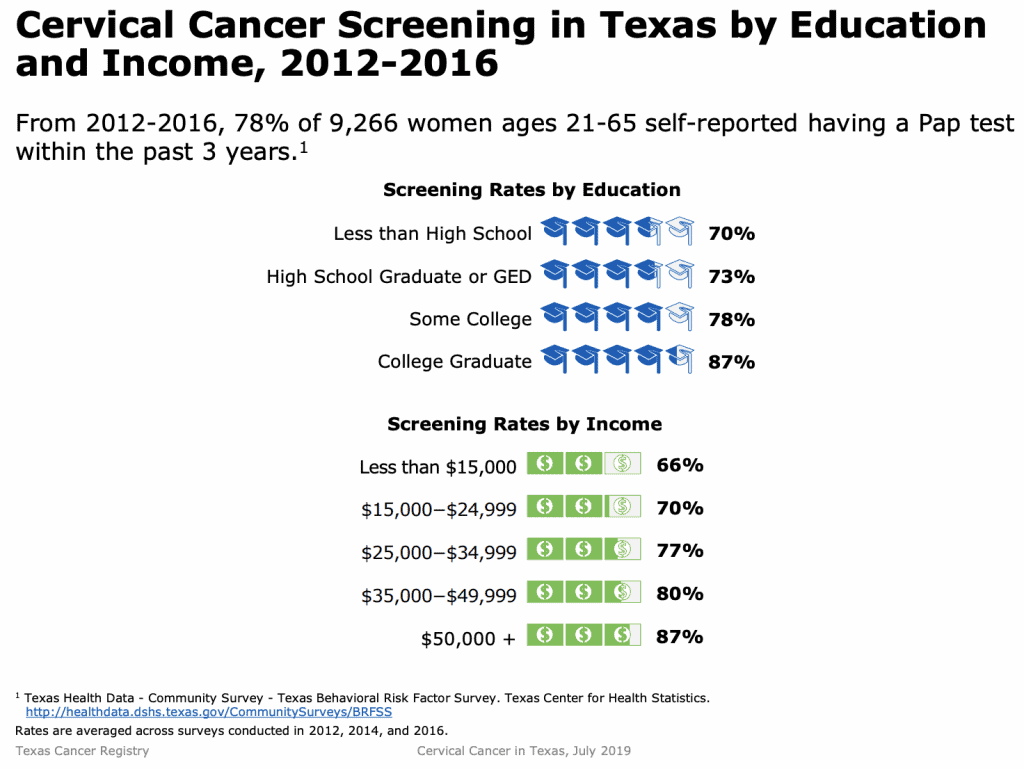
When to Get Screened
Regular Papanicolaou (Pap) and HPV tests, appropriate and timely treatment prevent cervical cancer and death. The American Cancer Society suggests:
Pap testing Every 3 years 21-29 years
HPV and Pap testing Every 5 years 30-65 years
Pap no HPV testing Every 3 years 30-65 years
Stop screening Total hysterectomy 65+ years
Listen to our Direct Primary Care partners in Detroit, Michigan Dr. Paul Thomas and Dr. Raquel Orlich of Plum Health DPC talk about the importance of Cervical Cancer Screening in women of Pap testing age.
Cancer Prevention
The American Cancer Society estimates that over 40% of cancer cases and deaths in the United States could be prevented with healthier lifestyles. The numbers look even better for cervical cancer. About 80% of deaths from cervical cancer could be prevented by regular screening, proper patient follow- up and treatment. Smoking, overweight, alcohol consumption and a sedentary lifestyle are all changes that could be made to reduce the risk of cancer.
Direct Med Clinic focuses on preventive care, which means you can learn to manage your overweight, diabetes, hypertension and other illnesses before they get out of control.
Don’t wait. Get your pap test now! $22 for members, $39.50 for non-members.
Not a member? Become one today!
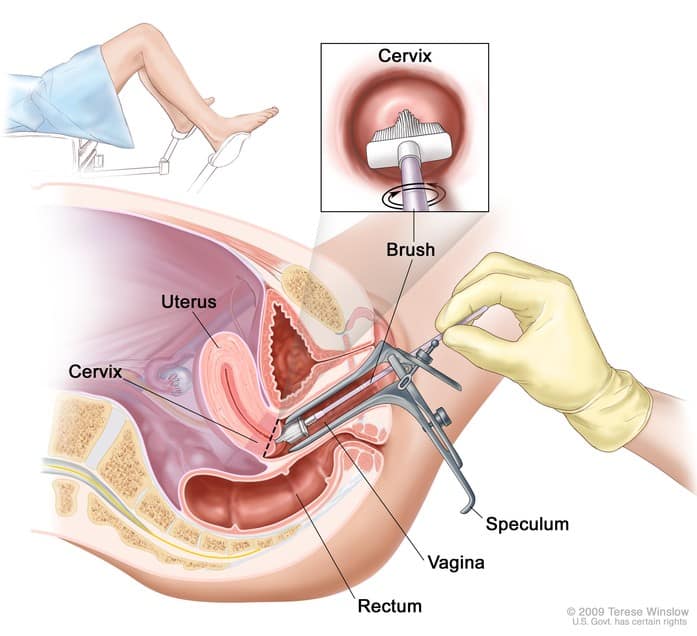


Recent Comments